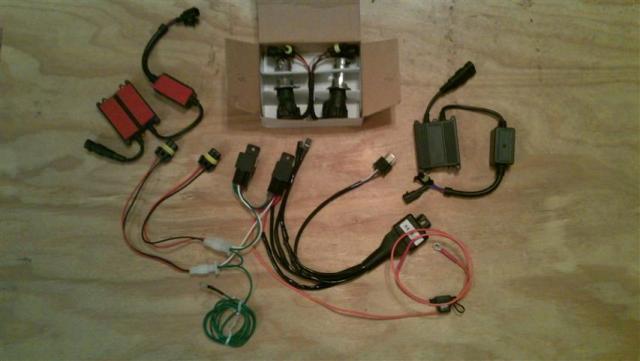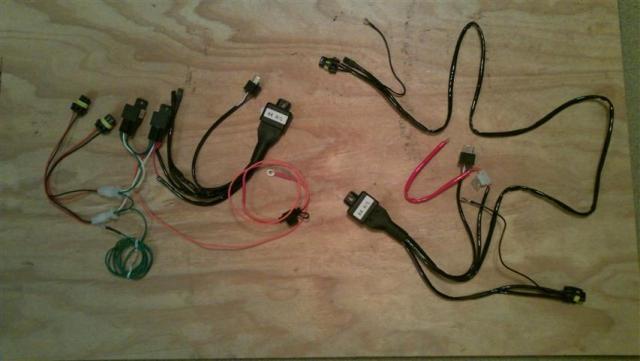-
Posts
1,689 -
Joined
-
Last visited
-
Days Won
1
Content Type
Forums
Profiles
Gallery
Blogs
Downloads
Events
Everything posted by Tightwad
-
I am finally shipping the first hi-lo H4 kit (the bulbs wanted were backordered). I totally reworked the DDM wiring...obviously intended for a car as the bulbs were 5 feet apart easily. After shortening everything and upgrading the fuse to a sealed unit and wiring the grounds to the battery instead of their cheesy setup I think it looks pretty good. The first picture is the custom kit including Latch and Delay relays, power and ground wires to the battery and showing the bulbs and ballasts. The second picture is the original wiring they provide next to my wiring. This is a much simpler install than the 6th gen except for figuring out where to put all the parts/pieces. I like how clean the 6th gen install is but I like how simple it could be...
-
I don't know about the beam patterns. I know people on this site have used them but I don't have a 5th gen to use for comparison.
-
I wonder if it was more a factor of the bike not charging at idle and spending so much time at stop and go speeds...battery drained and then the charging system overworked to keep up? I guess if a stator phase burned that wouldn't be it however.
-
You can store the stator no problem.
-
I have added H7 kits (European VFR) for the 6th gen to my site as well.
-
If he uses 2 H4 bulbs this kit will work. If he needs different bulbs he can contact me.
-
I have a HID bulb like this for some years now and it works brilliant. Thanks for the comment! I reiterate again to those considering...if you have any qualms or concerns please don't order. I haven't heard of anyone having issues but without first hand information I hesitate to make any guarantees and I wouldn't want anyone to be disappointed.
-
Good video...exactly what I was going to make...thanks for saving me the time!
-
Sorry, I thought we had discussed this. No problem explaining. The hi/lo bulbs have a motor on them that actually moved the bulb within the housing. This puts the beam into the "high beam" area of the reflector inside the headlight, allowing the beam to shine higher than normal. The bulb doesn't get brighter, it just changes the output. I will try to post a video of it in action. I have no personal experience with these setups so I can't offer anecdotal evidence. I suggest people investigate fully so they know what they are buying. I wouldn't normally offer anything I couldn't firmly stand behind with my own personal experience but this has been an oft requested item.
-
Ok, I have added the Hi/Lo H4 kit to my offerings. I took a different approach to this kit and made it a bit more of a "universal fit". I don't have pictures/videos for a how-to guide. I am hoping that this community can help in that respect. The kit is similar to the 6th gen kit but includes the Hi/Lo functionality. This increases the cost of the kit by my cost (+$20) but everything else remains the same. The kit will utilize the original H4 connector to trigger the high beam functionality. I fully expect the kit to change slightly based on initial feedback as well.
-
The clutch is on the right side, the Stator is on the left side. On the 2002+ bikes the R/R is on the right side creating the need to fish the wires across the motor rather blind. It shouldn't be an issue with your bike...I like the suggestion of using 2 long 6mm bolts as alignment pins as well.
-
I can't imagine a scenario where correctly installing the VFRness (making sure no connections are left unplugged when done) would result in a heat issue. Since this is a common Honda issue I am willing to bet it existed in some fashion all along and your voltmeter installation just showed it to you.
-

Is ignorance bliss? -- Need help with '00 charging system
Tightwad replied to realistdreamer's topic in Electrical
Are your heated grips on while having the voltage issue? You can do the Red/White wire testing on the Red wires in the VFRness...just probe into the back of the connector to touch the wire while it is hooked up. It isn't uncommon to discharge at idle, especially when you have something like Heated Grips running. I would leave them off in all testing and riding until you determine if the system is working correctly bare bones. Add back in accessories until the problem comes back and you can tell what is causing it. You don't need to do the additional grounding mod...the VFRness does that. Check that the purple wire gives the same voltage as the Red wire...it needs to match.- 22 replies
-
Just an update for those who have been asking...a 5th gen kit is close! I have a co-worker with a 1998 VFR that has agreed to let me use his bike for the measurements needed for a custom fit kit. I have 3 Hi/Lo kits on hand to make into 6th gen kits.
-

What to pay for? = 5th Gen electrical system
Tightwad replied to realistdreamer's topic in Electrical
The people on VFRD are amazing and very helpful! Let me know how everything works out for you.- 11 replies
-
- electrical system
- 5th gen
-
(and 1 more)
Tagged with:
-
This is what I did as well, an inline fuse between the battery and the relay. If you are only running 1 or 2 things off the relay, you don't necessarily have to have each of those fused too since the one going to the relay would catch a short. If you run a number of different things off that lead, it is best to use a fuse box and fuse the individual lines too. This is especially true if you are running something low powered with something high powered...like a radar detector with heated gear. The fuse needed for the heated gear is relatively high compared to the radar detector and you could easily destroy the radar detector without blowing the fuse. In this case run a fuse panel or at least fuse each accessory.
-

I dun sumpin bad... induced a short somewhere in electrical system
Tightwad replied to angst's topic in Electrical
The diodes only conduct positive toward the cathode: This is a schematic for a door chime but it's the same concept...two inputs for one output. Wire the mirrors where it says "to alarm positive door trigger input" and each of the 2 turn signal wires go where it says "positive trigger". Of course you ground the mirror as well.- 11 replies
-
- electric
- turn signal
- (and 4 more)
-
With all the wires burning up something is wrong...hopefully as easy as the battery but be sure to check everything after replacing/repairing the wiring and replacing the battery or you will just do it again. Where did you get the R/R from?
-
Based on the Honda part numbers I don't think so, sorry.
-

I dun sumpin bad... induced a short somewhere in electrical system
Tightwad replied to angst's topic in Electrical
This is a simple fix. Go to Radio Shack and buy some N4001 or similar diodes. Wire them into a V shape where power can only flow to the point of the V. Connect each leg of a V to your turn signal wires and the point of the V to the mirror lights. I have been running this for years with no issues. PM me if you want a set...it isn't expensive or time consuming.- 11 replies
-
- electric
- turn signal
- (and 4 more)
-
Best practice is to have a fuse before a wire goes anywhere it could short to ground...this includes inside a relay. My fuse panels use a fuse on the 30 pin.
-
I haven't had a failure yet from the Ricks Stators I have sold. I also hear there is a guy who can rewind yours...I don't have his companies name however.
-
I sell a repair kit for that connection if you need it or you can hardwire it (please use proper connectors etc)
-
Some aftermarket stators use red wires...the color of the wire won't affect how it operates. You will want to inspect that connection, the R/R connection and the starter relay connection as well. You will want to test the output of the stator as well as the R/R
-

5th generation speedometer (running backwards!!!!!!!!)
Tightwad replied to Primo's topic in Electrical
Not sure I can be much help but I will confirm that the direction you spin the sensor pickup in the drill shouldn't matter...it's measuring via hall effect I would guess and it doesn't know which way it is being run. My fear is that the needle was put on in the wrong spot and when you ran it, it bound up and damaged the speedo internals. Have you looked for used gauge clusters?



